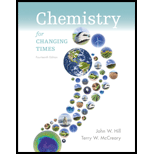
Concept explainers
a.
Interpretation:
Mass in grams of solute needed to prepare 0.250 L of 0.167 M  should be determined.
should be determined.
Concept introduction:
The concentration of any solution means the amount of solute present in the specific volume of the solvent. Now the amount of solute present in the solution is expressed by different units like gram, gram-equivalent, gram-mole or mole etc. The amount of solvent to prepare the solution can be expressed in terms of weight or volume. The different unit of expression the concentration of a solution are- percentage strength, normality, molarity, molality, formality, gram per litter, mole fraction, parts per million etc.
- Molarity: In per litter (1000 mL or 1000 cc) volume of any solution the amount of solute present in gram-mole is called the molarity of the solution. It is expressed by ‘M’. Like- If in 1 L of
 solution 2 gm-mole of the pure
solution 2 gm-mole of the pure  is present then the strength of the solution will be 2 M. It can be expressed as-
is present then the strength of the solution will be 2 M. It can be expressed as-

b.
Interpretation:
Mass in grams of solute needed to prepare 625 mL of 0.0200 M  should be determined
should be determined
Concept introduction:
The concentration of any solution means the amount of solute present in the specific volume of the solvent. Now the amount of solute present in the solution is expressed by different units like gram, gram-equivalent, gram-mole or mole etc. The amount of solvent to prepare the solution can be expressed in terms of weight or volume. The different unit of expression the concentration of a solution are- percentage strength, normality, molarity, molality, formality, gram per litter, mole fraction, parts per million etc.
- Molarity: In per litter (1000 mL or 1000 cc) volume of any solution the amount of solute present in gram-mole is called the molarity of the solution. It is expressed by ‘M’. Like- If in 1 L of
 solution 2 gm-mole of the pure
solution 2 gm-mole of the pure  is present then the strength of the solution will be 2 M. It can be expressed as-
is present then the strength of the solution will be 2 M. It can be expressed as-

Want to see the full answer?
Check out a sample textbook solution
Chapter 5 Solutions
Chemistry For Changing Times (14th Edition)
- What is the final product when D-galactose reacts with hydroxylamine?arrow_forwardIndicate the formula of the product obtained by reacting methyl 5-chloro-5-oxopentanoate with 1 mole of 4-penten-1-ylmagnesium bromide.arrow_forwardIn the two chair conformations of glucose, the most stable is the one with all the OH groups in the equatorial position. Is this correct?arrow_forward
- please help me with my homeworkarrow_forwardhelparrow_forwardThe temperature on a sample of pure X held at 1.25 atm and -54. °C is increased until the sample boils. The temperature is then held constant and the pressure is decreased by 0.42 atm. On the phase diagram below draw a path that shows this set of changes. pressure (atm) 2 0 0 200 400 temperature (K) Xarrow_forward
- QUESTION: Answer Question 5: 'Calculating standard error of regression' STEP 1 by filling in all the empty green boxes *The values are all provided in the photo attached*arrow_forwardpressure (atm) 3 The pressure on a sample of pure X held at 47. °C and 0.88 atm is increased until the sample condenses. The pressure is then held constant and the temperature is decreased by 82. °C. On the phase diagram below draw a path that shows this set of changes. 0 0 200 temperature (K) 400 аarrow_forwarder your payment details | bar xb Home | bartleby x + aleksogi/x/isl.exe/1o u-lgNskr7j8P3jH-1Qs_pBanHhviTCeeBZbufuBYT0Hz7m7D3ZcW81NC1d8Kzb4srFik1OUFhKMUXzhGpw7k1 O States of Matter Sketching a described thermodynamic change on a phase diagram 0/5 The pressure on a sample of pure X held at 47. °C and 0.88 atm is increased until the sample condenses. The pressure is then held constant and the temperature is decreased by 82. °C. On the phase diagram below draw a path that shows this set of changes. pressure (atm) 1 3- 0- 0 200 Explanation Check temperature (K) 400 X Q Search L G 2025 McGraw Hill LLC. All Rights Reserved Terms of Use Privacy Cearrow_forward
 ChemistryChemistryISBN:9781305957404Author:Steven S. Zumdahl, Susan A. Zumdahl, Donald J. DeCostePublisher:Cengage Learning
ChemistryChemistryISBN:9781305957404Author:Steven S. Zumdahl, Susan A. Zumdahl, Donald J. DeCostePublisher:Cengage Learning ChemistryChemistryISBN:9781259911156Author:Raymond Chang Dr., Jason Overby ProfessorPublisher:McGraw-Hill Education
ChemistryChemistryISBN:9781259911156Author:Raymond Chang Dr., Jason Overby ProfessorPublisher:McGraw-Hill Education Principles of Instrumental AnalysisChemistryISBN:9781305577213Author:Douglas A. Skoog, F. James Holler, Stanley R. CrouchPublisher:Cengage Learning
Principles of Instrumental AnalysisChemistryISBN:9781305577213Author:Douglas A. Skoog, F. James Holler, Stanley R. CrouchPublisher:Cengage Learning Organic ChemistryChemistryISBN:9780078021558Author:Janice Gorzynski Smith Dr.Publisher:McGraw-Hill Education
Organic ChemistryChemistryISBN:9780078021558Author:Janice Gorzynski Smith Dr.Publisher:McGraw-Hill Education Chemistry: Principles and ReactionsChemistryISBN:9781305079373Author:William L. Masterton, Cecile N. HurleyPublisher:Cengage Learning
Chemistry: Principles and ReactionsChemistryISBN:9781305079373Author:William L. Masterton, Cecile N. HurleyPublisher:Cengage Learning Elementary Principles of Chemical Processes, Bind...ChemistryISBN:9781118431221Author:Richard M. Felder, Ronald W. Rousseau, Lisa G. BullardPublisher:WILEY
Elementary Principles of Chemical Processes, Bind...ChemistryISBN:9781118431221Author:Richard M. Felder, Ronald W. Rousseau, Lisa G. BullardPublisher:WILEY





